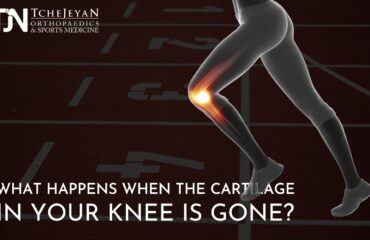Your knees are remarkable joints, enabling you to undertake an amazing range of activities. They bear a significant load with every step you take and withstand all the wear and tear of lifting and carrying objects, running upstairs, jumping down from platforms, standing up from a chair, and myriad other actions from the moment you learn to stand. When you run, your knees must withstand pressure equal to 11 times your body weight, and if you play any sport, from weight-lifting to basketball, you will demand even more from your knees.
It’s no wonder, then, that knee injuries occur with depressing regularity. Your knees are so critical to nearly every action you take that knee health is a crucial aspect of your overall well-being.
Knees are complex joints, with bones, ligaments, tendons, muscles, and cartilage working together to provide mobility. If any part of the knee joint suffers an injury, it can significantly impact your life. Cartilage damage is one injury we often encounter at Tchejeyan Orthopaedics and Sports Medicine.
The Role of Cartilage in Your Knee
Cartilage is the unsung hero in your knee joint. It’s a smooth, slippery tissue covering the bones that enables friction-free movement. Within the knee, in addition to the cartilage that covers the ends of your thigh and shin bones, are two semicircular pieces of rubbery cartilage called menisci that provide additional shock absorption between the bones. Tiny fluid-filled sacs called bursa also contribute to cushioning, allowing your knees to handle the forces they encounter.
What Causes Cartilage Damage?
Like any mechanical structure, your knee joint can sustain damage. The primary causes of cartilage damage are:
- Wear and Tear: Over time, from age or with excessive knee stress, the cartilage in your knee can wear down, leaving rough bone surfaces exposed causing bone-to-bone friction within the joint.
- Repetitive Actions: Activities involving twisting, jumping, and deep knee bends can gradually damage cartilage. Activities or occupations involving these movements (for example, baseball catchers) can cause cartilage degeneration.
- Traumatic Injuries: Forceful wrenching or direct impacts to the knee joint can result in traumatic injuries that involve cartilage damage.
Recognizing the Symptoms
When cartilage is damaged, it can lead to a range of symptoms, from a dull ache to sharp, debilitating pain, often accompanied by swelling and instability. Generally, cartilage damage manifests itself in the following ways:
- Catching Sensation: Torn cartilage may get caught between knee structures, leading to pain, swelling, and occasionally a locking or catching sensation.
- Instability and Weakness: You might experience a feeling of instability and weakness in your knee.
- Gait Alteration: Knee pain can cause changes in your gait, potentially leading to misalignment and discomfort in your knees, ankles, or hips.
Diagnosing and Treating Cartilage Damage
Diagnosing cartilage damage in the knee can be challenging if you only rely on the external effects, such as pain, swelling, or weakness as these symptoms are commonly associated with several types of knee conditions. Consequently, seeking the advice and analysis of a knee specialist is essential. An orthopedic doctor will conduct an evaluation that includes a thorough examination. The doctor will assess your range of motion, stability, and knee alignment, discuss your symptoms and events surrounding the injury, and utilize one or more imaging tests. Only then can your doctor make an accurate diagnosis.
The choice of treatment for cartilage damage depends on various factors, including your age, activity level, and the extent of the damage. If cartilage damage is left untreated, the injury can result in long-term consequences, such as osteoarthritis, so addressing the injury is paramount. Treatment options can be broadly categorized into non-surgical and surgical approaches.
For minor cartilage injuries, you may be able to avoid surgery. Non-surgical options may include modifying your activities either temporarily or permanently, physical therapy, anti-inflammatory medications, and lifestyle adjustments such as losing weight to alleviate pressure on the knee. Your doctor may also recommend using a knee brace. More aggressive non-surgical interventions can include injection of corticosteroids or hyaluronic acid.
For more severe injuries, surgery is often necessary. Thankfully, many knee surgeries can be performed arthroscopically, which speeds up recovery time. This method can be used for trimming damaged cartilage or removing broken pieces of cartilage. In some cases, you may need to remove the damaged cartilage and replace it with prosthetic cartilage.
Your orthopedic specialist has a range of options available, depending on the nature and severity of your injury. You can effectively manage cartilage damage with a timely diagnosis and appropriate treatment, and the proper therapy often enables an individual to regain full range of motion, relieved from pain and stiffness.
If you have a knee injury, contact TJN Ortho in Thousand Oaks, California, and schedule an appointment. Dr. T has been helping patients in the greater Los Angeles area for almost three decades. If you suspect cartilage damage, consult Dr. T to determine which treatment will get you on your feet and back to your favorite activities.




